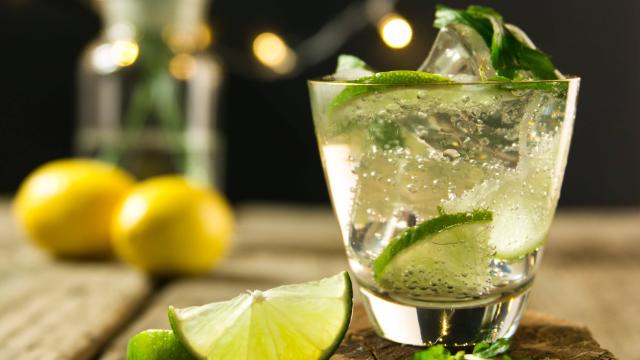The gin & tonic is thing of elegant simplicity but, since the mixer makes up the majority of the drink, a lot is riding on the tonic. Luckily, there are a lot of quality quinine-flavored offerings out there—including syrups! You just have to know what to look for.
Noted G&T historian and cocktail writer Camper English is almost overly familiar with the drink and, naturally, has some tips for making sure you pick a tonic water deserving of your gin.
There are clues in the bottle
First, you need to look at the bottle — both the ingredients list and the bottle itself. “Much of the quality of tonic water is due to the level of carbonation and the type and quantity of sweetener,” he explained.
“Carbonation holds up better in glass bottles, so hard pass on that two-litre supermarket brand and go for glass. Some tonic brands come in champagne-sized glass bottles now, which are good when you’re sharing.” In terms of sweetener, English advises drinkers to “look for tonics sweetened with something other than high fructose corn syrup, like cane sugar or agave syrup. If you’re a vodka tonic drinker, the floral flavored tonics (like elderflower) are designed for you.”
Skip the light stuff
Tonic water is a balancing act between bitter and sweet, but you don’t want that sweetness to be artificial. “To stand up to the bitter quinine, tonic water has a good amount of sweetener that can be overwhelming if you’re sugar-averse, especially if you’re having two or more,” said English.
“Rather than buying the light/diet versions that can have unpleasant tasting sweeteners, try cutting your tonic with half or a quarter of plain carbonated water. That also saves money; quality tonic is expensive.” In terms of brands, English looks for “East Imperial, Fever Tree, Q Tonic, and Thomas Henry, but availability varies widely by geography.”
Be careful with syrups
Tonic syrups, which allow you to take a more DIY approach by adding your own soda, are very popular right now, but there are few things you need to keep in mind when working with them. “Tonic syrups are usually made with ground up cinchona bark rather than isolated quinine, so they are typically earthy, barky-tasting, and brown rather than clear.
Also, because you’re adding the tonic syrup to carbonated water (and probably gin), there will be less overall carbonation in your mixed drink. You might want to give your Soda Stream an extra pump, or use Topo Chico [which has a lot of carbonation] to try to get it up to a proper level of fizz.”
If you’re the type to make everything from scratch, know that DIY tonic can actually cause some harm if you’re not careful. “If you’re trying your hand at making tonic syrup from online recipes, be sure to filter as much of the bark solids out as possible,” cautions English.
“It’s possible to overdose on cinchona alkaloids and give yourself a condition called cinchonism (tinnitus is the top identifiable symptom), especially when testing out recipes over and over. There are also concerns about quinidine, another alkaloid in cinchona bark, causing issues in people with a certain heart conditions at even lower levels.
(You can read more about quinine and tonic safety—and other potentially dangerous ingredients—at English’s CocktailSafe.org.)
In fact, this is one case where store-bought is more than fine. “The amount of cinchona alkaloids (quinine and others) in commercial tonic is regulated, but homemade stuff can easily push the limits,” explains English. So shop smart, stay alert, and maybe leave the tonic-making to the pros.

Comments